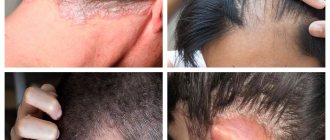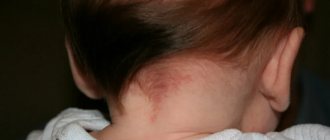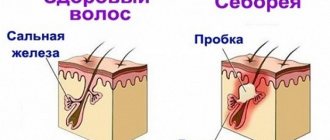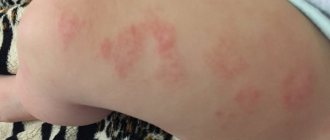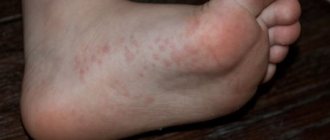Redness on the skin is a very unpleasant phenomenon for both adults and children. As a rule, they cause itching and flaking, which are sometimes accompanied by painful sensations. In addition, in each case, red spots look aesthetically unpleasant and repulsive. It is not surprising that every person strives to get rid of them as quickly as possible. And to do this, first of all, you need to understand the reasons for their occurrence, which can be very different. Moreover, sometimes redness on the skin indicates a very serious disease, including internal organs.
COST OF DERMATOLOGIST SERVICES IN OUR CLINIC IN ST. PETERSBURG
| Dermoscopy price | from 200 rub. |
| Dermatologist appointment | 1000 rub. |
| General blood analysis | from 160 rub. |
| Call free: 8-800-707-1560 *The clinic is licensed to provide urological services | |
What are the most common causes of red spots on the skin?
Psoriasis on hands
Typically, the first specific plaques appear on the palms and elbows. Doctors and researchers have not identified a specific reason for their appearance. You need to understand that psoriasis on the fingers (photo), as well as on the legs, head and other parts of the body, is not contagious and is not transmitted by shaking hands or personal objects. However, this does not mean that there is no need to rush to treat the disease, as it is fraught with serious complications.
Psoriasis at an early stage on the hands is difficult to miss.
The onset of the disease is accompanied by quite striking symptoms. Typically, single red papules (spots that rise above the skin level) appear on the palms and between the fingers. The rash looks like a regular allergy, so patients rarely go to a dermatologist at this stage and wait until the problem goes away on its own.
With the development of psoriasis, the papules merge with each other, forming plaques, and are covered with gray scales. It is then that the characteristic signs of the disease appear. Subsequently, the lesions do not peel off as much and stop growing. However, they look very repulsive, which is why many people experience severe psychological difficulties.
In adults, plaques covered with gray-white scales on the elbows, fingers, hands and palms can resemble lichen or fungus; as a rule, psoriatic plaques have a clear border.
It is also worth noting that when the disease affects the fingers, in most cases it also affects the nails. As a result, the nail plates become deformed and split at the edges. Fingers affected by psoriasis swell, which is often accompanied by pain in the joint area. The disease develops similarly in children.
Why does psoriasis develop on the legs?
Psoriasis on the legs is a chronic skin pathology that has a hereditary predisposition. The development of the disease is facilitated by the influence of predisposing factors. Factors predisposing to the development of psoriasis on the legs:
- Limb injuries - abrasions, cracks, wounds. In people prone to this pathology, they often become inflamed, accompanied by itching, and scratching. Against this background, psoriatic rashes appear. These causes most often cause psoriasis in the knee joints in children, adolescents and athletes.
- Skin diseases and foot abrasions. The disease especially often develops against the background of fungal infections. It is important to wear tight shoes, in which the feet sweat and get injured.
- Metabolic disorders, obesity, diabetes mellitus, endocrine diseases, age-related hormonal imbalances, pregnancy. Any hormonal imbalance can cause the onset of the disease.
- Any chronic processes and foci of infection leading to intoxication of the body.
- High emotional, mental and physical stress.
- Improper, irregular diet, intestinal dysbiosis.
- Immunity disorders.
Psoriasis of any localization can spread throughout the body, so do not delay treatment.
See how easily the disease can be cured in 10-12 sessions.
Exposure to one or more predisposing factors causes a chain reaction in the body:
- metabolism is disrupted;
- biologically active substances are released that stimulate the rapid division of surface cells of the skin epithelium; the formation of scales and peeling begins;
- Antibodies to your own skin cells are formed in the blood, an autoimmune inflammatory process begins - characteristic papules appear.
Psoriasis on the legs can develop on different parts of the skin, but most often the rash appears on the knees and feet. It also looks different.
Early stage psoriasis on hands
Initially, psoriatic rashes appear as small, smooth, round papules. One of the main differences is their clear outlines. This is how early-stage psoriasis begins on the hands (photo), the causes of which vary.
After a few days, the rashes become covered with light scales. They peel and fall off easily. Then the disease progresses, the rash increases in size and takes up more and more space.
Psoriasis on the fingers of the initial stage in most patients begins in the folds between the fingers, where the most suitable environment for the disease develops.
In general, the initial stage is characterized by three main features:
- a red papule (spot) appears;
- if you scratch the papule and remove the scales, a shiny, thin film appears, and if you scrape the film, droplets of blood appear on it.
In addition, at the initial stage of psoriasis, patients complain of swelling of the joints, redness of the skin and inflammation in the area near the nails. As the disease progresses, the papules stop growing and the peeling decreases.
How psoriasis begins on the hands and its symptoms can be seen in the presented photo. But you should not diagnose yourself, as there is a chance that you will confuse it with other skin diseases.
Signs of psoriasis on the hands
Typically, signs of psoriasis in women's hands are most pronounced on the palms. In men, the disease manifests itself less frequently in this area. This form of psoriasis is the most difficult to treat, since the palms are constantly in contact with detergents and objects surrounding the person.
Characterized by sharply defined plaques, against which there are multiple pustular rashes (pustules). Subsequently, they dry out, forming scale-crusts. The initial stage of psoriasis on the hands in the photo can be confused with other diseases: for example, with eczema or mycosis. Therefore, doctors perform a biopsy to confirm the diagnosis.
Signs of the disease differ depending on the location of the inflammation. Let's talk in more detail about each of them.
Fingers
With this form of the disease, psoriasis begins first between the fingers (pictured). The skin peels and becomes inflamed. Often symptoms worsen with the arrival of cold weather (autumn, winter). Without treatment, the problem leads to serious consequences.
Brushes
A quarter of affected people suffer from this form of psoriasis. The symptoms are similar to finger lesions. Problem areas become rough and covered with a red crust, similar in appearance to a callus. The spot also itches and brings all sorts of discomfort to the person.
Palms
As we have already said, this is one of the most painful forms of psoriasis because the affected skin is very itchy. Due to severe itching, patients often cannot sleep, which can cause neurosis. Characteristic is the appearance of plaques, against which there are multiple pustular rashes (pustules). Subsequently, they dry out, forming scale-crusts.
Joints
This type of psoriasis is also considered one of the most severe. It affects the joints of the hands between the phalanges, and then spreads to other joints. At the same time, at the initial stage, the disease may not appear on the skin, although the patient may already have joint pain. Inflammation in the joints is accompanied by redness of the skin over the affected joints, swelling, pain, limited mobility, and morning stiffness.
Benign growths:
Warts
The formations are caused by the human papillomavirus as a result of immune diseases or metabolic disorders. Most of them are harmless; only warts larger than 0.5 cm, flat or without clear contours and ovoid are dangerous.
Moles
Formations that arise due to excess in the skin of the coloring substance - melanin. Some of them can transform into malignant neoplasms – melanomas. To do this, the mole must be knot-like, dry, hairless, or bleeding.
Fibroids
Formations that look like a nodule that has grown deep into the skin and protrudes from it. The surface of fibromas is smooth and even, sometimes they develop into a malignant tumor - fibrosarcoma.
Zhiroviki
Tumors of the fatty layer that do not change skin color. They are carried painlessly and can be easily moved to the side with a finger. They form in areas of the body that are poor in adipose tissue: hips, shoulder blades, and upper back.
Atheromas
Formations resulting from blockage of the sebaceous gland duct. Painful to the touch, inflamed atheromas secrete purulent contents. Occurs in areas of increased sweating.
Hygromas
Cysts appearing in the joints and tendons. Hygromas do not change skin color and protrude greatly above the level of the body. They are usually harmless and painless.
Hemangiomas
Formations from cells of capillary or venous vessels are red and blue-black.
Psoriasis on the hands of children
In most cases, psoriasis on the hands of a child (pictured) occurs if one or both parents are predisposed to allergies and skin diseases. This tendency is transmitted genetically and may not manifest itself in any way until it is provoked by some factor. No one knows the exact reasons that provoke the development of the disease.
It is the hereditary theory of the occurrence of psoriasis in children that is supported by most doctors. It is believed that if one parent suffered from skin diseases, the child has a 25 percent chance of having the same problem. If both parents are prone to psoriasis, the child's chances of getting the disease reach 75 percent.
Provoking factors include stress, streptococcal infections, alcohol abuse, and medications.
Psoriasis is often combined with systemic diseases, including metabolic syndrome, type II diabetes mellitus, coronary heart disease, arterial hypertension, and pathology of the hepatobiliary system.
Whatever the cause of psoriasis, one thing can be said: this disease is not a superficial skin lesion. It indicates that the body has hidden underlying problems with internal organs.
If your family members have suffered from skin diseases, and especially psoriasis, you need to strictly monitor the child’s diet and diet, strengthen his immune system and maintain a healthy lifestyle. This will prevent the onset of the disease.
How does psoriasis develop on a child’s hands:
initial stage
The first psoriatic spots in young children are in many cases mistaken for a more common diathesis or allergy. Usually, in very young children, slight redness occurs first. The rash resembles round pimples of a red or pinkish hue. The rash remains smooth for several days, after which silvery, flaky scales form on it.
Progressive stage
This stage is characterized by an increase and fusion of spots. Peeling continues only in the middle of the spots, while they grow along the edges. The spots become red, itchy and inflamed. This stage can last two weeks or longer (up to several months). Then it goes into a regression stage, in which the spots stop growing and gradually disappear.
The disease can also affect the nails.
Attention! Many parents of children suffering from psoriasis are horrified by the fact that this chronic and rather painful disease can manifest itself throughout life. In this situation, the doctor must explain that if you follow a healthy regimen, eat right, use special cosmetics and avoid stress, then the disease may not manifest itself.
What will an examination with a dermatologist give?
Since there are a great many causes of skin redness, it is not recommended to “remove” and treat them on your own. And here it doesn’t matter whether we are talking about small rashes scattered throughout or locally located large spots. Flaky and itchy or not causing much concern.
Only an experienced dermatologist will be able to determine the disease, sometimes by the nature and location of the redness. But even in this case, he will definitely prescribe a comprehensive examination, including analysis of scrapings from the affected areas of the skin, which will allow timely clarification of symptoms, the correct selection of treatment therapy, and possibly diagnosis of a very serious disease, which at first glance has nothing to do with the condition of the skin. covers.
Symptoms of psoriasis on the hands
Symptoms of psoriasis on the hands are accompanied by constant itching, which can be treated with proper treatment. If the patient scratches the rash, numerous wounds can be seen on his skin. Typically, such wounds heal much faster in children than in adults.
The main symptoms of psoriasis on the hands:
- the skin turns red and dries out;
- the affected area swells and thickens;
- psoriatic lesions crack;
- single spots merge and may appear in new places;
- peeling usually worsens in winter;
- if the disease is not treated, the fingers swell and become covered with thickened, painful plaques;
- nails quickly become damaged, change color (become yellowish or brown), crack and become stained.
Treatment of psoriasis on hands and nails
Treatment of psoriasis on the hands and its symptoms is considered difficult. Even during periods of remission, spots may remain noticeable, although they decrease in size. To achieve the best effect, doctors use an integrated approach. In this case, numerous parameters are taken into account: the type of disease, the patient’s age, other pathologies, etc. A biopsy is used to confirm the diagnosis.
The following methods and means are used in the treatment of psoriasis:
- local keratolytic preparations (ointment, cream) for exfoliation and rejection of scales;
- ointments that help soften and heal the skin, and sometimes reduce itching and inflammation;
- antihistamines that fight swelling and itching;
- medications to support the liver and restore the functioning of the gastrointestinal tract;
- systemic therapy (biological drugs, systemic anti-inflammatory drugs);
- analgesics (if your nails or joints hurt);
- Psychological and pedagogical support also plays an important role in the treatment of psoriasis, especially in children.
Also, in the absence of contraindications, the patient may be prescribed physical therapy and phototherapy (UVB therapy and PUVA therapy).
Also, in the absence of contraindications, the patient may be prescribed physical therapy. A beneficial effect was shown by hand massage using healing creams and ointments that increase blood circulation. However, before using such products, it is better to consult with your doctor. He will eliminate the possibility of side effects and check for possible contraindications.
Effective methods for treating psoriasis on the legs
The following methods used in our clinic have been proven to be highly effective:
- PRP therapy - the essence of the method is that the patient is injected with his own blood enriched with platelets; Initially, blood is taken from a vein and injected pointwise into the affected areas of the skin of the legs; this leads to improved metabolic processes and suppression of the spread of psoriasis; helps well with all forms of disease;
- autohemotherapy - intramuscular injection of blood taken from the patient’s vein; has a general stimulating effect on the body;
- herbal medicine – the use of herbs and other medicinal plants. They are used as part of complex therapy to reduce the drug load on the patient’s body;
- acupuncture (acupuncture) is one of the methods of reflexology, the oldest method practiced by Chinese doctors; influence on special acupuncture points (AP) on the body and through them on various organs and tissues; specialists who are fluent in this technique can eliminate psoriatic rashes without the use of medications;
- vacuum therapy – exposure of the AT to rarefied air; for this purpose, special jars or devices are used;
- other methods of reflexology - cauterization with wormwood cigarettes, acupressure, auriculotherapy (impact on reflex points on the ear), etc.
How is leg psoriasis treated at Paramita Clinic?
A special feature of the Paramita clinic is the use of only effective methods of treating psoriasis on the legs at an affordable price. Both the most advanced European techniques and traditional oriental ones are used.
The correct choice and application of one or another method of therapy is possible only if the doctor has appropriate training and clinical experience. The clinic's doctors are fluent in all known methods of treating psoriasis, so it always takes place without side effects. All of them were trained in traditional healing methods in China and Tibet.
To avoid relapses, it is necessary to eliminate the cause of the disease.
Read more about our unique method of treating psoriasis
You can learn about the quality of treatment provided by Paramita specialists from reviews, as well as simply by asking visitors, because many of them are systematically treated at the clinic, maintaining a state of remission for years.
La-Cri cosmetics for hand psoriasis
Long-term remission can only be achieved if the main preventive measures are followed. People prone to psoriasis need to regularly moisturize their skin using cream or ointment. You should also prevent skin contact with cleaning products (wear gloves, etc.) and, of course, follow a diet.
Psoriasis leads to excessive dryness of the skin, so one of the main components of treatment should be hydration. But ordinary moisturizing creams are not suitable for psoriasis, as they may contain fragrances and other substances that can cause irritation. La-Cri cream for dry skin saturates the skin with fats, moisturizes it, reduces moisture loss and restores hydrolipid balance. The product can also be used to protect the skin from cold and windy weather.
This cream is based on natural ingredients and does not contain parabens, fragrances or chemical components. It is completely neutral and safe, so it is suitable even for pregnant women and children.
The La Cree line of neutral cosmetics also includes other products for the care of sensitive skin that can be used by people with skin diseases, including psoriasis. This cosmetics will help you maintain the beauty of your hands and prolong periods of remission as much as possible.
Clinical researches
The conducted clinical study proves the high efficiency, safety and tolerability of products for daily skin care of children with mild and moderate forms of atopic dermatitis and during remission, accompanied by a decrease in the quality of life of patients. As a result of therapy, a decrease in the activity of the inflammatory process, a decrease in dryness, itching and flaking was noted.
The products are recommended by the St. Petersburg branch of the Union of Pediatricians of Russia.
It has been clinically proven that La-Cri cream for dry skin moisturizes and nourishes the skin, relieves itching and irritation, and also soothes and restores the skin.
Sources:
- Chapman M. Shane, Habiff Thomas P., Zug Catherine A., Dinoulos James G. H., Campbell James L., Dermatology. Handbook of differential diagnosis, MEDpress-inform, 2014.
- Sukolin Gennady Ivanovich, Illustrated clinical dermatology. Brief alphabetical reference book, Lux Print publishing house, 2010.
- Sukolin Gennady Ivanovich, Clinical dermatology. A short guide to the diagnosis and treatment of dermatoses, Notabene, 2017.

